A Framework for Justice-Centering Relationships: Implications for Impact in Place-Based Community Engagement
DOI:
https://doi.org/10.18060/26450Keywords:
Community engagement, community impact, student learning, place-based community engagement, epistemic justiceAbstract
Community engagement in higher education has been promoted as critical to fulfilling higher education’s responsibility to the public good through teaching, learning, and knowledge generation. Reciprocity and mutual benefit are key principles of community engagement that connote a two-way exchange of knowledge and outcomes. However, it is not clear from existing literature whether community engagement impacts communities in positive ways.
The problem addressed through this study was how campus-community partnership stakeholders define impact. Using grounded theory, the ways community and campus partners defined, measured, and understood community impact in a diverse set of campus-community partnerships at two U.S. urban, Jesuit universities that employ place-based approach to community engagement were explored. Relationships as facilitators of impact and as impacts in and of themselves emerged as central themes. Themes from the data led to the development of the Justice-Centering Relationships Framework which includes two paradigms for understanding community impact in higher education community engagement – Plug-and-Play and Justice-Centering Relationships – that are bridged by a Reframing process. The Framework contributes to and informs the “how” of taking a place-based community engagement approach that leads to positive benefits for community impact, student learning and formation, and institutional change.
References
Bowen, G. A. (2006). Grounded theory and sensitizing concepts. International journal of qualitative methods, 5(3), 12-23. https://doi.org/10.1177/160940690600500304
Bryant, A., & Charmaz, K. (Eds.). (2007). The Sage handbook of grounded theory. London: Sage Publications Ltd. https://doi.org/10.4135/9781848607941
Butin, D. W. (2003). Of what use is it? multiple conceptualizations of service learning within education. Teachers College Record, 105(9), 1674-1692. https://doi.org/10.1177/016146810310500903
Carnegie Foundation for the Advancement of Teaching. (2015). Elective community engagement classification, first-time classification documentation framework. Retrieved from http://nerche.org/images/stories/projects/Carnegie/2015/2015_first-time_framework.pdf
Catala, A. (2015). Democracy, trust, and epistemic justice. The Monist, 98(4), 424-440. https://doi.org/10.1093/monist/onv022
Charmaz, K. (2014). Constructing Grounded Theory (2nd Ed.). London: Sage.
Community-Campus Partnerships for Health. (1998). Principles of Good Community Campus Partnerships. Retrieved from https://www.ccphealth.org/wpcontent/uploads/2017/10/confproc1998.pdf
Creswell, J. W. (2013). Qualitative inquiry and research design: Choosing among five approaches (3rd Ed.). Los Angeles, CA: Sage. https://doi.org/10.1086/317417
Cruz, N. I., & Giles, D. E. (2000). Where’s the community in service-learning research. Michigan Journal of Community Service Learning, 7(1), 28-34. http://hdl.handle.net/2027/spo.3239521.spec.104
Cruz, N. (2017). Centering communities in search of moral brilliance [Video]. YouTube. https://www.youtube.com/watch?reload=9&app=desktop&v=yuj5JcSJiks
Enos, S., & Morton, K. (2003). Developing a theory and practice of campus-community partnerships. Building Partnerships for Service-Learning (pp. 20-41). San Francisco: CA: John Wiley and Sons.
Jacoby, B. (Ed.). (2003). Building partnerships for service-learning. San Francisco, CA: Jossey-Bass.
Jameson, J., Clayton, P., & Jaeger, A. (2010). Community engaged scholarship as mutually transformative partnerships. In L.M. Harter, J. Hamel-Lambert, & J. Millesen (Eds.), Participatory partnerships for social action and research (pp. 259-277). Dubuque, IA: Kendall Hunt.
Minkler, M., & Wallerstein, N. (Eds.). (2008). Community-based participatory research for health: From process to outcomes. San Francisco, CA: John Wiley & Sons.
Mitchell, T. D. (2008). Traditional vs. critical service-learning: Engaging the literature to differentiate two models. Michigan Journal of Community Service Learning, 14(2), 50. http://hdl.handle.net/2027/spo.3239521.0014.205
Murray, R. (2020). Ignatian Leadership and Place-Based Learning. Jesuit Higher Education: A Journal 9(2). https://epublications.regis.edu/jhe/vol9/iss2/2
Ramaley, J. A. (2000). The perspective of a comprehensive university. In T. Ehrlich (Ed.), Civic responsibility and higher education (pp. 227-248). Westport, CT: Greenwood Publishing Group.
Rubin, V. (2000). Evaluating university-community partnerships: An examination of the evolution of questions and approaches. Cityscape, 219-230. https://www.jstor.org/stable/20868505
Saltmarsh, J., Hartley, M., & Clayton, P. (2009). Democratic engagement white paper. Boston, MA: New England Resource Center for Higher Education. Retrieved from https://repository.upenn.edu/gse_pubs/274
Sandy, M., & Holland, B. A. (2006). Different worlds and common ground: Community partner perspectives on campus-community partnerships. Michigan Journal of Community Service Learning, 13(1), 30-43. http://hdl.handle.net/2027/spo.3239521.0013.103
Shah, R. W. (2020). Rewriting Partnerships: Community Perspectives on Community-Based Learning. Louisville, CO: University Press of Colorado. https://doi.org/10.7330/9781607329602
Simpson, J. S. (2014). Longing for justice: Higher education and democracy's agenda. University of Toronto Press. https://doi.org/10.3138/9781442619661
Stoecker, R. (2016). Liberating service learning and the rest of higher education civic engagement. Philadelphia, PA: Temple University Press. https://doi.org/10.36366/frontiers.v30i3.429
Stoecker, R., Tryon, E. A., & Hilgendorf, A. (Eds.). (2009). The unheard voices: Community organizations and service learning. Philadelphia, PA: Temple University Press.
Sturm, S., Eatman, T., Saltmarsh, J., & Bush, A. (2011). Full participation: Building the architecture for diversity and public engagement in higher education. White Paper, Columbia University Law School, Center for Institutional and Social Change. https://surface.syr.edu/ia/17
Torres, J., & Schaffer, J. (2000). Benchmarks for campus/community partnerships. Providence, RI: Campus Compact.
Tuck, E. (2018). Biting the university that feeds us. In Spooner, M. & McNinch, J. (Eds.) Dissident knowledge in higher education, 149-167. University of Regina Press.
Wallerstein, N., Oetzel, J., Duran, B., Tafoya, G., Belone, L., & Rae, R. (2011). What predicts outcomes in CBPR. In M. Minkler & N. Wallerstein (Eds.), Community-based participatory research for health: From process to outcomes, (pp. 371-388). San Francisco, CA: Jossey-Bass.
Weerts, D. J., & Sandmann, L. R. (2008). Building a two-way street: Challenges and opportunities for community engagement at research universities. The Review of Higher Education, 32(1), 73-106. https://doi.org/10.1353/rhe.0.0027
Yamamura, E., & Koth, K. (2018). Place-Based Community Engagement in Higher Education: A Strategy to Transform Universities and Communities. Sterling, VA: Stylus.
Downloads
Published
Issue
Section
License
Copyright (c) 2023 Melissa Quan

This work is licensed under a Creative Commons Attribution 4.0 International License.



